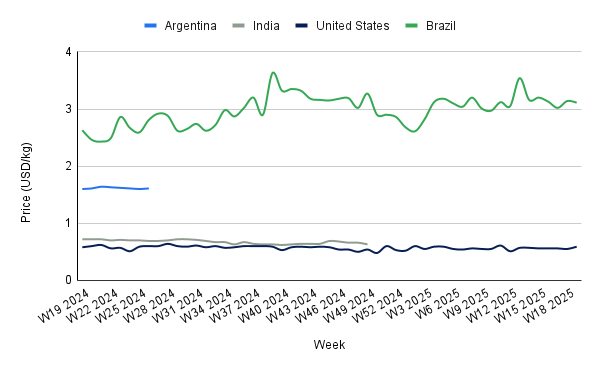W19 2025: Peanut Weekly Update

In W19 in the peanut landscape, some of the most relevant trends included:
- Peanut prices in India declined in W19, with limited market activity and low buyer interest despite state governments releasing stocks. Downward price pressure persists even amid expectations of reduced sowing, though demand for high-quality varieties from oil producers offered some support.
- Mexico's 2025 Fertilizers for Well-being Program is distributing significant fertilizer quantities (DAP and UREA) to nearly 200,000 farmers and peanut producers in Oaxaca, aiming to improve crop yields.
- In the US, peanut planting in Arkansas is progressing slowly, with 11% planted and only 3% emergence by W19, lagging behind other major crops that are ahead of historical averages.
- Brazil’s peanut prices showed a slight weekly decline to USD 3.11/kg but remained 18.25% higher YoY, supported by strong harvest volumes and quality. However, ongoing rainfall poses risks of harvest delays and crop losses, which could tighten supply and push prices upward in the medium term.
1. Weekly News
India
Indian Peanut Prices Continue to Fall in W19 Amid Weak Demand and Limited Market Activity
Peanut prices in India continued to decline as of W19, with limited market activity over the past two weeks and there is little expectation of a near-term recovery. Despite prospects of reduced sowing in the upcoming season, downward pressure on prices persists. State governments are gradually releasing stocks, yet buyer interest remains low. Some support is emerging from increasing demand for high-quality varieties, particularly from oil producers.
Mexico
Oaxaca Peanut Growers Benefit from National Fertilizer Program Supporting Key Crops in 2025
Peanut producers in Oaxaca are among the beneficiaries of Mexico's 2025 Fertilizers for Well-being Program, which began fertilizer deliveries to nearly 200,000 farmers in the state. Approximately 60,000 metric tons (mt) of fertilizer, split between Diammonium Phosphate (DAP), a widely used phosphorus fertilizer that also provides nitrogen, and urea, a nitrogen-rich fertilizer, will be distributed through 89 centers. Each farmer, including peanut growers, will receive up to 300 kilograms (kg) per hectare (ha) for a maximum of two ha. The program supports key crops, including peanuts, and aims to enhance food self-sufficiency and rural livelihoods through free, direct input distribution.
United States
Arkansas Peanut Planting Progresses Slowly in W19
Peanut planting in Arkansas continues at a gradual pace, with 11% of the crop planted as of W19, according to the United States Department of Agriculture (USDA) data. This marks a 6% increase from the previous week. Emergence remains limited, with only 3% of peanuts emerging. While other major crops such as corn, rice, and soybeans are progressing well and ahead of historical averages, peanut development is still in its early stages.
2. Weekly Pricing
Weekly Peanut Pricing Important Exporters (USD/kg)

Yearly Change in Peanut Pricing Important Exporters (W19 2024 to W19 2025)

United States
In W19, United States (US) wholesale peanut prices rose to USD 0.59/kg, reflecting a 7.27% week-on-week (WoW) and 1.72% year-on-year (YoY) increase. This price movement occurs alongside a projected 11% expansion in planted acreage for 2025, reaching 1.95 million acres, driven by reduced profitability in competing row crops and sustained returns from peanut cultivation, particularly in irrigated areas. Georgia leads this expansion with a 12% YoY increase, mirrored across much of the Southeastern US. While current price gains suggest stable demand, the acreage surge and potential for favorable yields raise oversupply concerns. If realized, high production levels and existing carryover stocks could place downward pressure on prices in the latter half of 2025.
Brazil
In W19, Brazil's peanut prices declined slightly to USD 3.11/kg, down by 0.96% WoW, but still reflecting an 18.25% YoY increase from USD 2.63/kg. This modest weekly drop aligns with strong harvest volumes and high-quality output reported in W17, supporting favorable export opportunities in the near term. However, ongoing rainfall remains a key risk factor. If wet conditions persist, harvest delays and potential crop losses could tighten supply, exerting upward pressure on prices. Therefore, while current prices show short-term softness, continued weather disruptions could reverse the trend and push prices higher in the medium term.
3. Actionable Recommendations
Enhance Production Efficiency and Quality in Key Regions
Peanut producers, especially in Mexico’s Oaxaca region, benefiting from fertilizer support, should maximize the use of distributed inputs like DAP and UREA to improve yield and quality. This can help meet rising demand for high-quality peanuts, particularly from oil producers, and strengthen competitiveness amid price volatility in markets.
Diversify Supply Sources to Mitigate Weather and Planting Risks
Given slow planting progress in the US (Arkansas) and weather-related risks in Brazil, peanut buyers and processors should diversify sourcing across multiple producing regions to ensure supply stability. Strategic long-term contracts with growers can help balance supply fluctuations caused by climate and planting delays.
Target Premium Segments and Export Opportunities
Producers and exporters should focus on promoting high-quality peanut varieties to oil processors and international markets. Leveraging Brazil’s strong harvests and favorable export conditions, while monitoring weather risks, can capture growth opportunities in export demand despite short-term price softness. Marketing efforts highlighting quality and reliability will support premium positioning.
Sources: Tridge, Brownfield News, Ciudadanía Express, Mundus Agri



